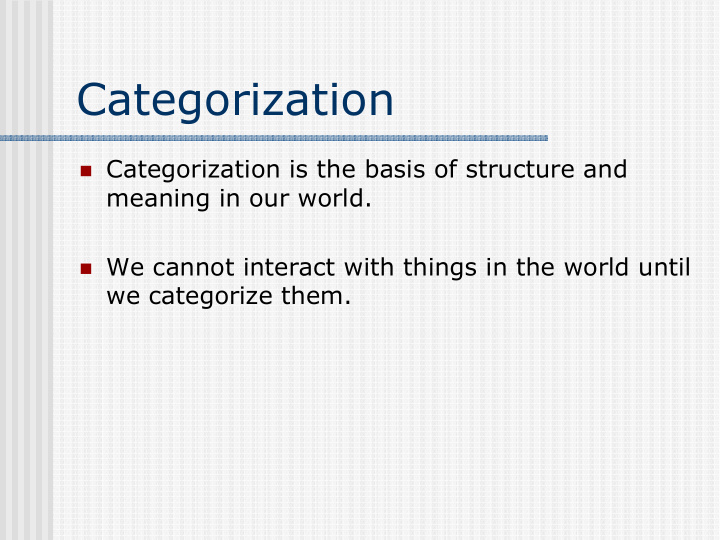



Categorization � Categorization is the basis of structure and meaning in our world. � We cannot interact with things in the world until we categorize them.
Categorization � Categorization is our biological imperative � Even amoebas must distinguish food from non- food � Animals with brains can have many more categories, and there can be hierarchical category structure � A huge amount of categorization goes on at the subconscious level
Edge Detection Retinal ganglion cells perform an early stage of Information processing The receptive field of each ganglion cell has a characteristic center-surround property. That is, one portion of the receptive field will be excitatory, and the other inhibitory. These regions are organized in a circularly symmetric fashion so that either the excitatory region is surrounded by the inhibitory region, or vice- versa
Edge detection
Edge detection � Edge detection represents low level categorization process � Reduction in detail � Increase in information
Association � Brains are massive associators � Experiencing 2 stimuli simultaneously causes synaptic changes Hebbian Learning Rule When neuron A repeatedly participates in firing neuron B, the strength of the action of A onto B increases.
Association Example: classical conditioning Initial state: smell of food triggers salivation
Association If a bell sounds every time food is presented, salivation response co-occurs with bell
Association After some number of co-occurrences, connection strength increases so that bell alone induces salivation
Association Co-occurrence of features facilitates category formation [miaU]
Association Some feature may be absent, still trigger cat recognition [miaU]
Association Too few features present, may not recognize cat ?
categorization � Zwaan & Madden’s referent representation vs. linguistic representation � Referent representations – traces (firing patterns) occurring as a result of exposure to objects/events in the world � Linguistic representations – traces occurring as a result of exposure to linguistic input (including production experiences) � High interconnectedness within and between each type
Association Referent and linguistic representations associated Cat [miaU]
Association � Category recognition can be triggered by different feature patterns � Features are also categories
Classical model of categorization Aristotle Every category has its essence , that which defines it Ex. Man is a two-footed animal Categories are defined in terms of necessary � and sufficient features Features are binary � Categories have clear boundaries � All members of a category have equal status �
Categorization - Wittgenstein � Wittgenstein � Category boundaries are fuzzy � Members of a category do not always share a set of common properties � Ex. Game • Winning/losing – part of some games but not all (game of catch) • Skill involved • Luck involved � Family resemblances � Categories must be learned by exemplars
Categorization - Labov � Labov � Categorization study for household containers (cup, mug, bowl, etc.)
Categorization - Labov � Features can be gradient • Depth/width ratio continuous • Handle not just present or absent � Function important • Mashed potatoes inside � bowl • Coffee inside � cup/mug � Presence of features does not determine category membership but rather influences probability of categorization
Categorization – prototype theory � Certain members of a category are prototypical – or instantiate prototype � Categories form around prototypes; new members added on basis of resemblance to prototype � No requirement that a property or set of properties be shared by all members � Category membership a matter of degree � Categories do not have clear boundaries
Recommend
More recommend